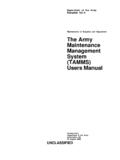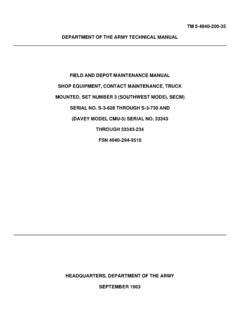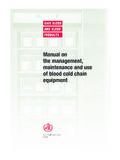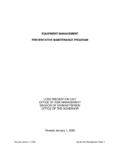Transcription of Content Sheet 3-1: Equipment Management …
1 Equipment Module 3 Content Sheet 1 Content Sheet 3-1: Equipment Management overview Role in quality Management system Equipment Management is one of the essential elements of a quality Management system. Proper Management of the Equipment in the laboratory is necessary to ensure accurate, reliable, and timely testing. The benefits of a good Equipment Management program are many: helps to maintain a high level of laboratory performance; reduces variation in test results, and improves the technologist s confidence in the accuracy of testing results; lowers repair costs, as fewer repairs will be needed for a well-maintained instrument; lengthens instrument life; reduces interruption of services due to breakdowns and failures; increases safety for workers; produces greater customer satisfaction.
2 Program considerations A great deal of thought and planning should go into Equipment Management . As the laboratory puts an Equipment Management program in place the following elements should be considered: Selection and purchasing When obtaining new Equipment what criteria should be used to select Equipment ? Should Equipment be purchased, or would it be better to lease? Installation For new Equipment , what are the installation requirements, and who will install the new instrument? Calibration and performance evaluation What is needed to calibrate and validate that the Equipment is operating correctly? How will these important procedures be conducted for both old and new instruments?
3 Maintenance What maintenance schedule is recommended by the manufacturer? Will the laboratory need additional preventive maintenance Equipment Module 3 Content Sheet 2 procedures? Are current maintenance procedures being conducted properly? Troubleshooting Is there a clear procedure for troubleshooting for each instrument? Service and repair What is the cost? Can the laboratory obtain the necessary service and repair in its geographical area? Retiring and disposing of Equipment What must be done to dispose of old Equipment when it needs to be replaced? Oversight It is the responsibility of the laboratory director to: oversee all the Equipment Management systems in the laboratory; ensure that all persons who will be using the instruments have been appropriately trained and understand how to both properly operate the instrument and perform all necessary routine maintenance procedures.
4 Equipment Management responsibility may be specifically assigned to a technologist in the laboratory. In many laboratories there is a person who has good skills with Equipment maintenance and troubleshooting. Giving this person the role of oversight of all Equipment is recommended. Oversight of an Equipment Management program includes: assigning responsibilities for all activities; assuring that all personnel are trained on operation and maintenance; monitoring the Equipment Management activities: o review all Equipment records routinely; o update maintenance procedures as necessary; o ensure that all procedures are followed. Note: day-to-day maintenance should be the responsibility of the technical operator.
5 Everyone who uses the Equipment should be trained in calibration and daily maintenance. Equipment Module 3 Content Sheet 3 Content Sheet 3-2: Selecting and Acquiring Equipment Selecting Equipment Selecting the best instrument for the laboratory is a very important part of Equipment Management . Some criteria to consider when selecting laboratory Equipment are listed below. Why and how will the Equipment be used? The instrument should be matched against the service the laboratory provides. What are the performance characteristics of the instrument? Is it sufficiently accurate and reproducible to suit the needs of the testing to be done? What are the facility requirements, including the requirements for physical space?
6 Will the cost of the Equipment be within the laboratory s budget? Will reagents be readily available? Will reagents be provided free of charge for a limited period of time? If so, for how long? How easy will it be for staff to operate? Will instructions be available in a language that is understood? Is there a retailer for the Equipment in the country, with available services? Does the Equipment have a warranty? Are there any safety issues to consider? If the decisions about purchasing are made outside the laboratory, for example by a central purchasing body, the laboratory manager should provide information that will support selecting Equipment that will best serve the needs of the laboratory.
7 In areas where there are national programs for purchasing standard Equipment , the laboratories of the country should have some input to decisions. In addition, in areas where donors are likely to provide some of the Equipment that is used, laboratory Management should have input into choice of Equipment . If this is not possible, Management should consider declining Equipment , if inappropriate for laboratory needs. Acquiring Equipment Is it better to purchase, rent or lease Equipment ? When making this decision, it is a good idea to factor in repair costs. The initial cost of an instrument may seem reasonable, but it may be expensive to repair. Also consider savings that could be negotiated if the laboratory needs more than one piece of Equipment .
8 The manufacturer should provide all of the necessary information to operate and maintain Equipment . Equipment Module 3 Content Sheet 4 Before purchasing ask if: wiring diagrams, computer software information, a list of parts needed, and an operator s manual are provided; the manufacturer will install the Equipment and train staff (covering travel expenses as necessary) as part of the purchase price; the warranty includes a trial period to verify that the instrument performs as expected; the manufacturer s maintenance can be included in the contract and if so, whether maintenance is provided on a regular basis. Determine if the laboratory can provide all the necessary physical requirements, such as electricity, water, and space.
9 There must be adequate room to move the Equipment into the laboratory; consider door openings and elevator access. Installing Equipment Before Equipment is installed, verify that all physical requirements (electrical, space, doors, ventilation, and water supply) have been met. Other things to consider are: The vendor s responsibilities for installation should be confirmed in writing prior to beginning the installation process. A checklist of the expected performance specifications should be developed, so that performance can be quickly verified as soon as the Equipment is installed. Whenever possible, it is best to have the manufacturer install laboratory Equipment ; this will likely improve the conditions of the warranty, and also may ensure that the installation is done properly and quickly.
10 If Equipment is installed by the laboratory: check that the package contents contain all of the parts; make a copy of any software that is part of the system; do not allow the Equipment to be used before it is completely installed, performance is verified, and testing personnel are trained. Equipment Module 3 Content Sheet 5 Content Sheet 3-3: Getting Equipment Ready for Service After installation After Equipment has been installed, the following details need to be addressed before putting the Equipment into service: assign responsibility for performing the maintenance and operation programs; develop a system for recording the use of parts and supplies (see Module 4- Purchasing and Inventory overview ); implement a written plan for calibration, performance verification, and proper operation of the Equipment ; establish a scheduled maintenance program that includes daily, weekly, and monthly maintenance tasks; provide training for all operators.
















